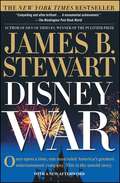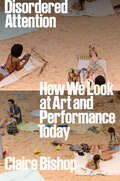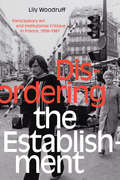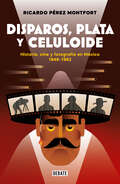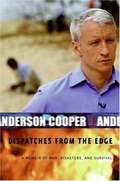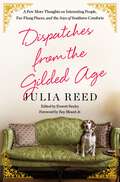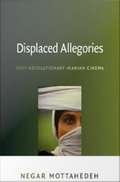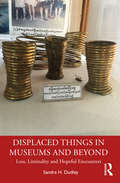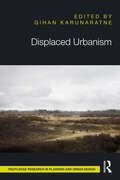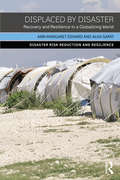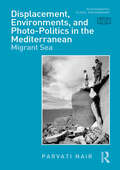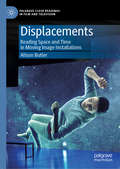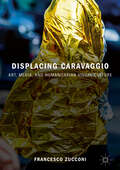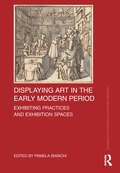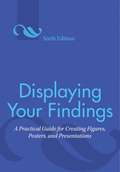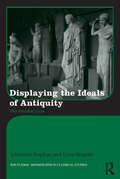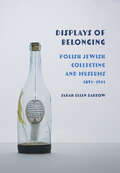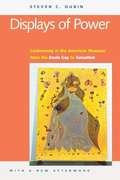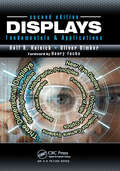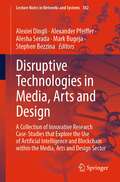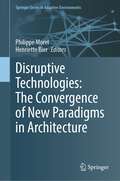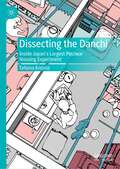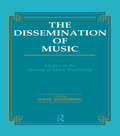- Table View
- List View
Disney/Pixar The Color of Toy Story: A 30th Anniversary Celebration of Colorscripts and Creativity (Disney/Pixar)
by Pixar Animation StudiosCelebrate the 30th anniversary of Disney and Pixar’s Toy Story with this collection of colorscripts and development art from all four Toy Story feature films.Relive the magic of meeting Woody, Buzz, Andy, and the rest of the characters from Pixar’s first feature film for the first time. Follow along in the colorscripts as the unforgettable story arc unfolds across four Toy Story films and discover rare visual development art that brought such beloved characters to life.Copyright © 2025 Disney Enterprises, Inc. and Pixar. All rights reserved.30th ANNIVERSARY COLLECTOR’S ITEM: For 30 years, Pixar has been using colorscripts to visually explore the emotional arc of their films. Pick up this gorgeous hardcover book for a look back at how these colorscripts have changed as techniques and technologies have evolved. Toy Story fans will treasure the chance to relive the story again and again, reference each frame, and page through beloved scenes.RARE DEVELOPMENT ART: Each colorscript is accompanied by rare development art featuring the key characters and color design of each film. Learn how the beloved characters of Toy Story formed in the minds of their creators. See for yourself how Pixar’s artists and animators experimented with color and design to bring Woody, Buzz, Andy, and all the toys to life. EXPERIENCE THE FULL STORY: Relive the complete story of all four films in a new medium and appreciate the artistic work that goes into every frame of a Toy Story film. Watch the beloved characters grow over the years and prepare for what comes next. MORE DETAIL THAN EVER BEFORE: Immerse yourself in the complete story, so far, in unforgettable detail with art that fills the page. See for yourself how Pixar’s talented animators and artists introduce new characters into the story, build emotional climactic scenes, and make memorable miniature worlds full of detail.Perfect for:Animation enthusiasts, filmmakers, and studentsFans of Disney and PixarFans of the collectible Art of series and The Color of PixarAdding to the shelf or coffee table with bestselling movie art books like The Art of Elemental, The Art of Turning Red, and The Art of Soul
DisneyWar: The Battle for the Magic Kingdom
by James B. Stewart"When You Wish Upon a Star," "Whistle While You Work," "The Happiest Place on Earth" -- these are lyrics indelibly linked to Disney, one of the most admired and best-known companies in the world. So when Roy Disney, chairman of Walt Disney Animation and nephew of founder Walt Disney, abruptly resigned in November 2003 and declared war on chairman and chief executive Michael Eisner, he sent shock waves through the entertainment industry, corporate boardrooms, theme parks, and living rooms around the world -- everywhere Disney does business and its products are cherished. DisneyWar is the breathtaking, dramatic inside story of what drove America's best-known entertainment company to civil war, told by one of our most acclaimed writers and reporters. Drawing on unprecedented access to both Eisner and Roy Disney, current and former Disney executives and board members, as well as thousands of pages of never-before-seen letters, memos, transcripts, and other documents, James B. Stewart gets to the bottom of mysteries that have enveloped Disney for years: What really caused the rupture with studio chairman Jeffrey Katzenberg, a man who once regarded Eisner as a father but who became his fiercest rival? How could Eisner have so misjudged Michael Ovitz, a man who was not only "the most powerful man in Hollywood" but also his friend, whom he appointed as Disney president and immediately wanted to fire? What caused the break between Eisner and Pixar chairman Steve Jobs, and why did Pixar abruptly abandon its partnership with Disney? Why did Eisner so mistrust Roy Disney that he assigned Disney company executives to spy on him? How did Eisner control the Disney board for so long, and what really happened in the fateful board meeting in September 2004, when Eisner played his last cards? Here, too, is the creative process that lies at the heart of Disney -- from the making of The Lion King to Pirates of the Caribbean. Even as the executive suite has been engulfed in turmoil, Disney has worked -- and sometimes clashed -- with a glittering array of stars, directors, designers, artists, and producers, many of whom tell their stories here for the first time. Stewart describes how Eisner lost his chairmanship and why he felt obliged to resign as CEO, effective 2006. No other book so thoroughly penetrates the secretive world of the corporate boardroom. DisneyWar is an enthralling tale of one of America's most powerful media and entertainment companies, the people who control it, and those trying to overthrow them. DisneyWar is an epic achievement. It tells a story that -- in its sudden twists, vivid, larger-than-life characters, and thrilling climax -- might itself have been the subject of a Disney animated classic -- except that it's all true.
Disordered Attention: How We Look at Art and Performance Today
by Claire BishopHow technology and the politics of attention changed the way we look at artThe ways we encounter contemporary art and performance has changed. How are we expectedto engage with today's diverse practice? Is the old model of close-looking still the ideal, or has itgiven way to browsing, skimming, and sampling?Across four provocative and insightful essays, art historian and critic Claire Bishop identifies trends in contemporary practice. Charting a critical path through the last three decades, Bishop pinpoints how spectatorship and visual literacy are evolving under the pressures of digital technology.She explores how researched-based exhibitions have proliferated turning the artist into an investigator or archivist with mixed results. Spatial performance can now involve the artist, dancers, or even the audience as participants, often framed with Instagram in mind. The political event is not longer activated without an understanding of the media that will record and distribute it. The proliferation of works that use modernist architecture is noticeable; but has this become a shorthand for something else?Disordered Attention is a vital survey of 21st century art, from one of the leading art thinkers ofour times.
Disordering the Establishment: Participatory Art and Institutional Critique in France, 1958–1981 (Art History Publication Initiative)
by Lily WoodruffIn the decades following World War II, France experienced both a period of affluence and a wave of political, artistic, and philosophical discontent that culminated in the countrywide protests of 1968. In Disordering the Establishment Lily Woodruff examines the development of artistic strategies of political resistance in France in this era. Drawing on interviews with artists, curators, and cultural figures of the time, Woodruff analyzes the formal and rhetorical methods that artists used to counter establishment ideology, appeal to direct political engagement, and grapple with French intellectuals' modeling of society. Artists and collectives such as Daniel Buren, André Cadere, the Groupe de Recherche d’Art Visuel, and the Collectif d’Art Sociologique shared an opposition to institutional hegemony by adapting their works to unconventional spaces and audiences, asserting artistic autonomy from art institutions, and embracing interdisciplinarity. In showing how these artists used art to question what art should be and where it should be seen, Woodruff demonstrates how artists challenged and redefined the art establishment and their historical moment.
Disparos, plata y celuloide: Historia, cine y fotografía en México 1846-1982
by Ricardo Pérez MontfortEn cierto sentido, la historia no es lo que ocurrió, sino lo que creemos que ocurrió. Piense usted en Pancho Villa. La imagen que tiene en la mente fue fijada por una fotografía o una película. Y sucede exactamente igual con Lázaro Cárdenas, Emiliano Zapata, una adelita, «un tendero gallego de los años cincuenta», «un apacible pueblito de provincia», cualquier «rancho de inicios del siglo XX» y, de hecho, con buena parte de los grandes momentos, referencias y personajes de la historia mexicana.En este sentido, el cine y la fotografía nos han “enseñado” más historia que los libros de la SEP. En esta obra, el historiador Ricardo Pérez Montfort ofrece una serie de ensayos sobre este fenómeno. ¿Cómo es que la memoria colectiva ha sido delineada por el celuloide? ¿Qué mitos de la historia patria son culpa de los haluros de plata? ¿Cuáles son algunas de las representaciones másdelirantes de los próceres mexicanos? ¿Qué significa que nuestra educación histórica se haya forjado en salas oscuras? ¿Quién da forma a la memoria de un país? Con una prosa rigurosa y entrañable, el autor inicia su recorrido a finales del siglo XIX, transita por el Porfiriato, “observa a los observadores” de la Revolución, atestigua la conformación identitaria del México moderno, mira cómo el cine ha construidohéroes y demonios, y termina con un drama cuya importancia no hemos terminado de aquilatar: el incendio de la Cineteca Nacional en 1982.
Dispatches from the Edge: A Memoir of War, Disasters, and Survival
by Anderson CooperFew people have witnessed more scenes of chaos and conflict than Cooper, whose groundbreaking coverage on CNN has changed the way we view the news.
Dispatches from the Gilded Age: A Few More Thoughts on Interesting People, Far-Flung Places, and the Joys of Southern Comforts
by Julia ReedDispatches from the Gilded Age is a collection of essays by Julia Reed, one of America's greatest chroniclers.In the middle of the night on March 11, 1980, the phone rang in Julia Reed’s Georgetown dorm. It was her boss at Newsweek, where she was an intern. He told her to get in her car and drive to her alma mater, the Madeira School. Her former headmistress, Jean Harris, had just shot Dr. Herman Tarnower, The Scarsdale Diet Doctor. Julia didn’t flinch. She dressed, drove to Madeira, got the story, and her first byline and the new American Gilded Age was off and running.The end of the twentieth century and the beginning of the twenty-first was a time in which the high and the low bubbled furiously together and Julia was there with her sharp eye, keen wit, and uproariously clear-eyed way of seeing the world to chronicle this truly spectacular era. Dispatches from the Gilded Age is Julia at her best as she profiles Andre Leon Talley, Sister Helen Prejean, President George and Laura Bush, Madeleine Albright, and others. Readers will travel to Africa and Cuba with Julia, dine at Le Bernardin, savor steaks at Doe’s Eat Place, consider the fashions of the day, get the recipes for her hot cheese olives and end up with the ride of their lives through Julia’s beloved South. With a foreword by Roy Blount, Jr. and edited by Julia's longtime assistant, Everett Bexley.
Displaced Allegories: Post-Revolutionary Iranian Cinema
by Negar MottahedehFollowing the 1979 Iranian Revolution, Iran's film industry, in conforming to the Islamic Republic's system of modesty, had to ensure that women on-screen were veiled from the view of men. This prevented Iranian filmmakers from making use of the desiring gaze, a staple cinematic system of looking. In Displaced Allegories Negar Mottahedeh shows that post-Revolutionary Iranian filmmakers were forced to create a new visual language for conveying meaning to audiences. She argues that the Iranian film industry found creative ground not in the negation of government regulations but in the camera's adoption of the modest, averted gaze. In the process, the filmic techniques and cinematic technologies were gendered as feminine and the national cinema was produced as a woman's cinema. Mottahedeh asserts that, in response to the prohibitions against the desiring look, a new narrative cinema emerged as the displaced allegory of the constraints on the post-Revolutionary Iranian film industry. Allegorical commentary was not developed in the explicit content of cinematic narratives but through formal innovations. Offering close readings of the work of the nationally popular and internationally renowned Iranian auteurs Bahram Bayza'i, Abbas Kiarostami, and Mohsen Makhmalbaf, Mottahedeh illuminates the formal codes and conventions of post-Revolutionary Iranian films. She insists that such analyses of cinema's visual codes and conventions are crucial to the study of international film. As Mottahedeh points out, the discipline of film studies has traditionally seen film as a medium that communicates globally because of its dependence on a (Hollywood) visual language assumed to be universal and legible across national boundaries. Displaced Allegories demonstrates that visual language is not necessarily universal; it is sometimes deeply informed by national culture and politics.
Displaced Things in Museums and Beyond: Loss, Liminality and Hopeful Encounters
by Sandra H. DudleyDisplaced Things in Museums and Beyond looks anew at the lives, effects and possibilities of things. Starting from the perspectives of things themselves, it outlines a particular, displacement approach to the museum, anthropology and material culture. The book explores the ways in which the objects are experienced in their present, displaced settings, and the implications and potentialities they carry. It offers insights into matters of difference and the hope that may be offered by transformative encounters between persons and things. Drawing on anthropological studies of ritual to conceptualise and examine displacement and its implications and possibilities, Dudley develops her arguments through exploration of displaced objects now in museums and dislocated or exiled from their prior geographical, historical, cultural, intellectual and personal contexts. The book’s approach and conclusions are relevant far beyond the museum, showing that even in the most difficult of circumstances there is agency, distinction and dignity in the choices and impacts that are made, and that things and places as well as people have efficacy and potency in those choices. In Displaced Things, displacement emerges as fundamental to understanding the lives of things and their relationships with human beings, and the places, however defined, that they make and pass within. The book will be essential reading for academics and students engaged in the study of museums, heritage, anthropology, culture and history.
Displaced Urbanism (Routledge Research in Planning and Urban Design)
by Gihan KarunaratneThis book critically interrogates dominant narratives surrounding displacement by offering an in-depth examination of how it unfolds across diverse urban and rural settings worldwide. It addresses the intricate realities of displacement and its impact on the built environment.Through a series of case studies spanning cities, refugee camps, and small towns, the book reveals how communities are uprooted and resettled not solely due to conflict or political unrest but also to economic shifts, environmental changes, and urban development. Challenging conventional dichotomies between voluntary and forced migration and formal and informal resettlement, this volume advocates for a nuanced understanding of displacement that captures the lived experiences of affected communities. Examining the politics of space-making in urban contexts, the book interrogates the roles of governments, private corporations, and individuals in shaping displacement dynamics. Thematic sections provide diverse perspectives on the creation, transformation, and contestation of urban spaces in the context of mobility and migration.This volume critically analyzes the socio-spatial transformations prompted by displacement, bringing together scholars from anthropology, architecture, urban planning, and related fields. It examines the socio-spatial shifts triggered by displacement, emphasizing the role of human agency in navigating and reshaping environments under displacement conditions. This collection is essential for scholars and students in architecture, urban studies, sociology, and migration studies, as well as practitioners and professionals engaged in urban development and policymaking.
Displaced by Disaster: Recovery and Resilience in a Globalizing World (Disaster Risk Reduction and Resilience)
by Ann-Margaret Esnard Alka SapatDisplacement has traditionally been conceptualized as a phenomenon that results from conflict or other disruptions in developing or unstable countries. Hurricane Katrina shattered this notion and highlighted the various dilemmas of population displacement in the United States. The dilemmas stem from that of inconsistent terminology and definitions; lack of efforts to quantify displacement risk potential and that factor displacement vulnerability into community plans; lack of understanding of differential needs of "displacees" especially during long-term recovery periods; and policy and institutional responses (or lack thereof) especially as it relates to post-disaster sheltering and housing. Incorporating relevant examples, cases, and policies Esnard and Sapat look at the experience of other countries and how the international community has dealt with hundreds of thousands of individuals who have been forced to leave their homes. Displaced by Disaster addresses such issues from a planning and policy perspective informed by scholarship in disciplines such as emergency management; political science; sociology and anthropology. It is ideal for students and practitioners working in the areas of disaster management, planning, public administration and policy, housing, and the many disciplines connected to disaster issues.
Displacement, Environments, and Photo-Politics in the Mediterranean: Migrant Sea (Photography, Place, Environment)
by Parvati NairFocusing on the Mediterranean region from 2015 onwards, this volume explores photography’s engagement with displacement, a process that denotes the environmental and social breakdown of places and the forced mobility of people.The ongoing proliferation of photography of the displaced plays a crucial role in shaping opinions, by sensitising the public to the despair of displacement and hardening them to the trope through repeated exposure. Through a range of images by both established and amateur photographers, as well as ethnographic notes that draw from interviews with actors who are either displaced or working with the displaced, Parvati Nair questions the extent to which photography opens a space of possibility for the displaced in the face of globally dominant ideological drives that lead to the Anthropocene. Chapters focus on key aspects of this mass phenomenon, such as the question of crises no longer as exception but as historical process, the lived experiences of protracted relegation to borders and exposure to possible death, the prevalence of domicide and the spread of encampments, and the question of hope for the future.The book will be of interest to scholars in photography theory, migration and refugee studies, art history, Mediterranean studies, and political science.
Displacements: Reading Space and Time in Moving Image Installations (Palgrave Close Readings in Film and Television)
by Alison ButlerThis book is about the aesthetics and politics of contemporary artists’ moving image installations, and the ways that they use temporal and spatial relationships in the gallery to connect with geopolitical issues. Displaced from the cinema, moving images increasingly address themes of movement and change in the world today. Digital technology has facilitated an explosion of work of this kind, and the expansion of contemporary art museums, biennales and large-scale exhibitions all over the world has created venues and audiences for it. Despite its 20th century precursors, this is a new and distinct artistic form, with an emerging body of thematic concerns and aesthetics strategies. Through detailed analysis of a range of important 21st century works, the book explores how this spatio-temporal form has been used to address major issues of our time, including post-colonialism, migration and conflict. Paying close attention to the ways in which moving images interact with the specific spaces and sites of exhibition, the book explores the mobile viewer’s experiences in these immersive and transitory works.
Displacing Caravaggio: Art, Media, and Humanitarian Visual Culture
by Zakiya Hanafi Francesco ZucconiThis book takes its start from a series of attempts to use Caravaggio’s works for contemporary humanitarian communications. How did his Sleeping Cupid (1608) end up on the island of Lampedusa, at the heart of the Mediterranean migrant crisis? And why was his painting The Seven Works of Mercy (1607) requested for display at a number of humanitarian public events? After critical reflection on these significant transfers of Caravaggio’s work, Francesco Zucconi takes Baroque art as a point of departure to guide readers through some of the most haunting and compelling images of our time. Each chapter analyzes a different form of media and explores a problem that ties together art history and humanitarian communications: from Caravaggio’s attempt to represent life itself as a subject of painting to the way bodies and emotions are presented in NGO campaigns. What emerges from this probing inquiry at the intersection of art theory, media studies and political philosophy is an original critical path in humanitarian visual culture.
Displaying Art in the Early Modern Period: Exhibiting Practices and Exhibition Spaces (Routledge Research in Art Museums and Exhibitions)
by Pamela BianchiFrom aesthetic promenades in noble palaces to the performativity of religious apparatus, this edited volume reconsiders some of the events, habits and spaces that contributed to defining exhibition practices and shaping the imagery of the exhibition space in the early modern period. The contributors encourage connections between art history, exhibition studies, and architectural history, and explore micro-histories and long-term changes in order to open new perspectives for studying these pioneering exhibition-making practices. Aiming to understand what spaces have done and still do to art, the book explores an underdeveloped area in the field that has yet to trace its interdisciplinary nature and understand its place in the history of art. The book will be of interest to scholars working in art history, museum studies, exhibition history, and architectural history.
Displaying Your Findings: A Practical Guide For Creating Figures, Posters, And Presentations
by Adelheid Nicol Penny PexmanThis new edition offers readers essential guidance on creating figures that effectively present their findings. Figure examples have been updated to reflect reporting standards and graphics presentation outlined in the sixth edition of the Publication Manual.
Displaying the Ideals of Antiquity: The Petrified Gaze (Routledge Monographs in Classical Studies #15)
by Johannes Siapkas Lena SjögrenDisplaying the Ideals of Antiquity investigates the study and display of ancient sculpture from archaeological, art historical, and museum studies perspectives. Ancient sculptures not only give us knowledge about ancient Greek and Roman pasts, but they also mediate ideals that inform modern perceptions of antiquity. This book analyzes how an art historical tradition establishes and preserves an idealized view of antiquity in classical archaeology and in museum exhibitions. The authors investigate how these ideals are kept alive today—an approach that often is neglected in studies on ancient reception.This book offers an international scope and illustrates how academic conceptual foundations influence museum exhibitions.This timely volume discusses contemporary museum exhibitions of ancient sculpture and clarifies how old discourses continue to affect museum exhibitions and conceptualizations of ancient sculptures. The authors analyze close to 100 museums around the world, and demonstrate the ways in which ancient sculptures are mediated across Europe and the West.
Displays of Belonging: Polish Jewish Collecting and Museums, 1891–1941
by Sarah Ellen ZarrowDisplays of Belonging illuminates the lives and work of Polish Jewish collectors and museologists, who sought to preserve the treasures of the Jewish past while demonstrating Jewish belonging on Polish soil. As Jews comfortable in the Polish language and within Polish artistic and academic society, they saw themselves as intermediaries between less-integrated Jews and the Polish cultural elite.At the turn of the century, Jewish ethnographers and museum creators staked their claim to belonging to the civic nation though the display of Jewish folk art, fine art, and Judaica. After the First World War, the nearly three million Jews in the Second Polish Republic were suddenly challenged with finding a place for themselves in a state that increasingly defined itself as a creation of the ethnic Polish nation, to which Jews, by many accounts, did not belong.By tracing emergent documentation and display practices in partitioned Poland and in the interwar Second Polish Republic, Sarah Ellen Zarrow offers a better understanding of how integrated Jews identified with Polish culture and history and with non-Jewish Poles, and how they conceived of, negotiated, and argued their collective place within Poland. This is not a case of assimilation, nor of acculturation, but rather of displaying a parallel culture that was at once similar and yet distinctive.Displays of Belonging offers a nuanced understanding of the multiplicity of ways in which Jews in Poland saw their present and dreamed of their future. It places Jewish ethnographic practice and art collection within a Polish context, and sheds light on ways in which ideas about belonging and national identity were negotiated in the space of museums.
Displays of Power: Controversy in the American Museum From the Enola Gay to Sensation!
by Steven C. DubinMuseums have become ground zero in America's culture wars. Whereas fierce public debates once centered on provocative work by upstart artists, the scrutiny has now expanded to mainstream cultural institutions and the ideas they present. In Displays of Power, Steven Dubin, whose Arresting Images was deemed "masterly" by the New York Times, examines the most controversial exhibitions of the 1990s. These include shows about ethnicity, slavery, Freud, the Old West, and the dropping of the atomic bomb by the Enola Gay. This new edition also includes a preface by the author detailing the recent Sensation! controversy at the Brooklyn Museum. Displays of Power draws directly upon interviews with many key combatants: museum administrators, community activists, curators, and scholars. It authoritatively analyzes these episodes of America struggling to redefine itself in the late 20th century.
Displays: Fundamentals & Applications, Second Edition
by Rolf R. Hainich Oliver BimberIn the extensive fields of optics, holography and virtual reality, technology continues to evolve. Displays: Fundamentals and Applications, Second Edition addresses these updates and discusses how real-time computer graphics and vision enable the application and displays of graphical 2D and 3D content. This book explores in detail these technological developments, as well as the shifting techniques behind projection displays, projector-camera systems, stereoscopic and autostereoscopic displays. This new edition contains many updates and additions reflecting the changes in fast developing areas such as holography and near-eye displays for Augmented and Virtual reality applications. Perfect for the student looking to sharpen their developing skill or the master refining their technique, Rolf Hainich and Oliver Bimber help the reader understand the basics of optics, light modulation, visual perception, display technologies, and computer-generated holography. With almost 500 illustrations Displays will help the reader see the field of augmentation and virtual reality display with new eyes. Features: • Covers physics, technology and techniques behind flat-panel as well as projection displays, projector-camera systems, stereoscopic and autostereoscopic displays, computer-generated holography, and near-eye displays • Discusses how real-time computer graphics and computer vision enable the visualization of graphical 2D and 3D content • Augmented by close to 500 rich illustrations, which give readers a clear understanding of existing and emerging display technology
Dispute Resolution and Conflict Management in Construction: An International Perspective (Cib Ser.)
by Peter Fenn Michael O’Shea Edward DaviesMany construction conflicts and disputes are not limited to particular jurisdictions or cultures, but are increasingly becoming common across the industry worldwide. This book is an invaluable guide to international construction law, written by a team of experts and focusing on the following national systems: Australia, Canada, China, England and Wales, Estonia, Hong Kong, Iraq, Ireland, Italy, Japan, Malaysia, the Netherlands, Oman, Portugal, Quebec, Romania, Scotland, Sweden, Switzerland, and the USA. The book provides a consistent and rigorous analysis of each national system as well as the necessary tools for managing conflict and resolving disputes on construction projects.
Disruptive Technologies in Media, Arts and Design: A Collection of Innovative Research Case-Studies that Explore the Use of Artificial Intelligence and Blockchain within the Media, Arts and Design Sector (Lecture Notes in Networks and Systems #382)
by Alexiei Dingli Alexander Pfeiffer Alesha Serada Mark Bugeja Stephen BezzinaThis book presents selected proceedings from two installments of the MAD Conference in 2020—MAD Blockchain 2020 and MAD Artificial Intelligence 2020. These events focused on applications of these novel technologies in media, arts and design. A number of researchers present their own projects and practical implementations of blockchain and AI in games, art, education and sustainable living, while other authors explore theoretical and ethical questions that these technologies bring into society. First and foremost, we recommend this book to aspiring scholars and practitioners who are also building new solutions using blockchain and AI. Besides, the book extends the existing scholarship on AI and blockchain and provides proven cases and tools for education in ICT. The conference has been organized by Danube-University Krems, Drexel University Philadelphia and University of Malta with support from the MIT Education Arcade, the Texas A&M LIVE Lab and University of Vaasa.
Disruptive Technologies: The Convergence of New Paradigms in Architecture (Springer Series in Adaptive Environments)
by Henriette Bier Philippe MorelThrough a series of highly speculative contributions by both leading and highly acclaimed practitioners and theorists, this book gives a new comprehensive overview of architectures’ most recent practical and theoretical developments. While a few chapters are mostly dedicated to a historical analysis of how we got to experience a new technological reality in architecture and beyond, all chapters including the most forward looking, have in common their rigorous understanding of history as a pool of radical experiments, whether one speaks of the history of architecture, or of sociology, technology, and science. Disruptive Technologies: The Convergence of New Paradigms in Architecture is required reading for anybody student, practitioner, and educator who wants to do serious research in architecture and all disciplines dealing with the shaping of our environment, beyond the important but restricted domain of computational architectural design.Additional multimedia content via app: download the SN More Media app for free, scan a link with play button and access to the Additional Contents directly on your smartphone or tablet.
Dissecting the Danchi: Inside Japan’s Largest Postwar Housing Experiment
by Tatiana KnorozThe book is the first to explore the history and political significance of the Japanese public housing program. In the 1960s, as Japan's postwar economy boomed, architects and urban planners inspired equally by Western modernism and Soviet ideas of housing as a basic right created new cityscapes to house populations turned into refugees by the war. Over time, as Japan's society aged and the economy began to stagnate, these structures have become a burden on society. In this closely researched monograph on the conditions of Japanese housing, Tatiana Knoroz sheds unexpected light on the rise and fall of the idea of social democracy in Japan which will be of interest to historians, architects, and scholars of Asian economic modernization.
Dissemination of Music: Studies in the History of Music Publishing (Musicology #14)
by Hans LennebergFirst Published in 1995. Routledge is an imprint of Taylor & Francis, an informa company.

